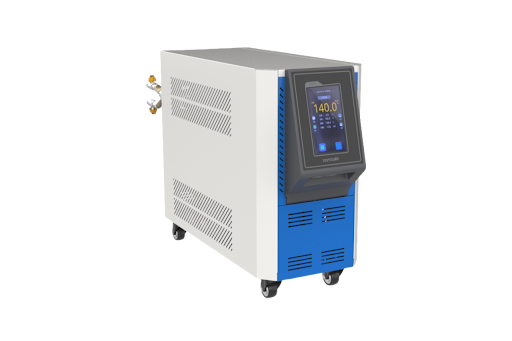Clear product visuals, uniform wall thickness, and precise dimensional stability are critical for a wide range of applications, from medical devices to consumer electronics. Defects such as haze, flow marks, weld lines, sink marks, and warpages affect both aesthetics and functionality. Fortunately, mould temperature controller offer a robust solution. By precisely regulating the temperature of the mould surface and internal channels, the device optimizes polymer flow, solidification, and stress distribution.
Mould Temperature Controller: Improving Surface Finish on Transparent Parts
Transparent parts require impeccable surface quality to meet optical clarity requirements. Any irregularities in the mould surface translate directly into visible defects, such as flow marks, vapour marks, or surface haze. Mould temperature controllers ensure that the mould reaches and maintains the optimal temperature before and during injection, thereby improving the surface finish.
First, the mould temperature controller’s preheat function gradually raises the mould temperature to the target range, typically between 80°C and 120°C for many transparent polymers. This uniformly elevated temperature minimizes the formation of a skin layer and reduces surface tension differences as the melt front advances. As a result, the polymer film flows more smoothly over the cavity walls, eliminating flow marks and transient striations. Maintaining the mould temperature within ±0.5°C of the set point ensures uniform solidification front movement, which prevents localized crystallization and differential shrinkage zones that lead to fogging.
Mould temperature controller and optimized flow behaviour for thin-walled sections
Thin-wall geometries present challenges in terms of flow and packing. Rapid melt flow through narrow flow channels can result in incomplete filling, weld lines, or excessive shear heating. Mold temperature controllers address these issues by fine-tuning the heat distribution along the flow channels.
By setting slightly higher temperatures in the upstream zone and gradually increasing the temperature toward the cavity exit, the controller ensures that the polymer viscosity remains low during the critical filling phase. This zoning approach, enabled by the multi-zone temperature control unit, prevents premature freezing of gates and runners. As a result, the melt front reaches the end with sufficient pressure and temperature to fill the thin-walled structure. In addition, this targeted temperature management reduces shear stress on the polymer chains, maintains molecular orientation, and prevents flow-induced degradation.
Ensures uniform wall thickness and prevents warpage
One of the most common defects of thin-walled parts is warpage, which is caused by uneven cooling and differential shrinkage. Mould temperature controllers address this issue by ensuring uniform heat distribution throughout all mould areas.
The controller uses advanced PID control to continuously monitor thermocouple feedback and adjust the heater or coolant flow to maintain the target temperature in each area. This precise regulation prevents local hot or cold spots from causing uneven solidification. As a result, polymer chains in all parts of the part shrink evenly, minimizing internal stresses that cause geometric distortion. Additionally, during the packing and holding phases, the mould temperature controller can be adjusted to slightly increase the temperature, thereby extending the holding time and preventing premature solidification of the skin.
Fast thermal response protects delicate thin-wall features.
Rapid thermal transitions can damage delicate structures such as micro-ribs, fine holes or optical channels. Mould temperature controllers mitigate thermal shock by implementing controlled temperature gradients before and after injection.
During startup, the mould temperature controller’s preset heating profile smoothly heats the mould to operating temperature, preventing sudden thermal gradients between the mould and the molten polymer. Once the injection cycle is complete, the mould temperature controller switches to a programmed cooling profile, adjusting the coolant temperature and flow rate to prevent sudden temperature drops. This gentle thermal cycle reduces the likelihood of microcracks or stress fractures in thin-walled parts. Industry tests prove it reduces scrap, extends mould life, and maintains consistent part quality—even with sub-0.5mm thicknesses.
Dynamic Control for Clear Part Transparency
Optical clarity requires not only surface finish but also internal uniformity. Residual stresses and micropores within the polymer cause light to scatter, resulting in haze. The mould temperature controller dynamically adjusts the mould temperature based on real-time process feedback to eliminate these internal defects.
The mould temperature controller is integrated with the injection moulding machine control system and receives cycle-by-cycle data from melt pressure, cavity fill time, and internal temperature sensors. If changes occur, the mould temperature controller immediately adjusts zone temperatures to compensate, ensuring that the polymer temperature remains above its glass transition temperature until the cavity is filled and pressure is maintained. This adaptive approach prevents premature solidification and avoids air entrapment or stress focus.
Eliminate Defects with Mold Temperature Controllers
Producing defect-free, transparent, thin-walled parts requires meticulous thermal management. As we’ve seen, mould temperature controllers cover all critical aspects, from the surface finish and flow properties to warpage control, dynamic response, and process monitoring. By ensuring uniform temperature distribution, enforcing controlled temperature gradients, and accommodating real-time process changes, controllers can avoid the optical and structural defects that once limited the potential of complex polymer parts.
READ MORE 5 Simple Shed Organization Tips
